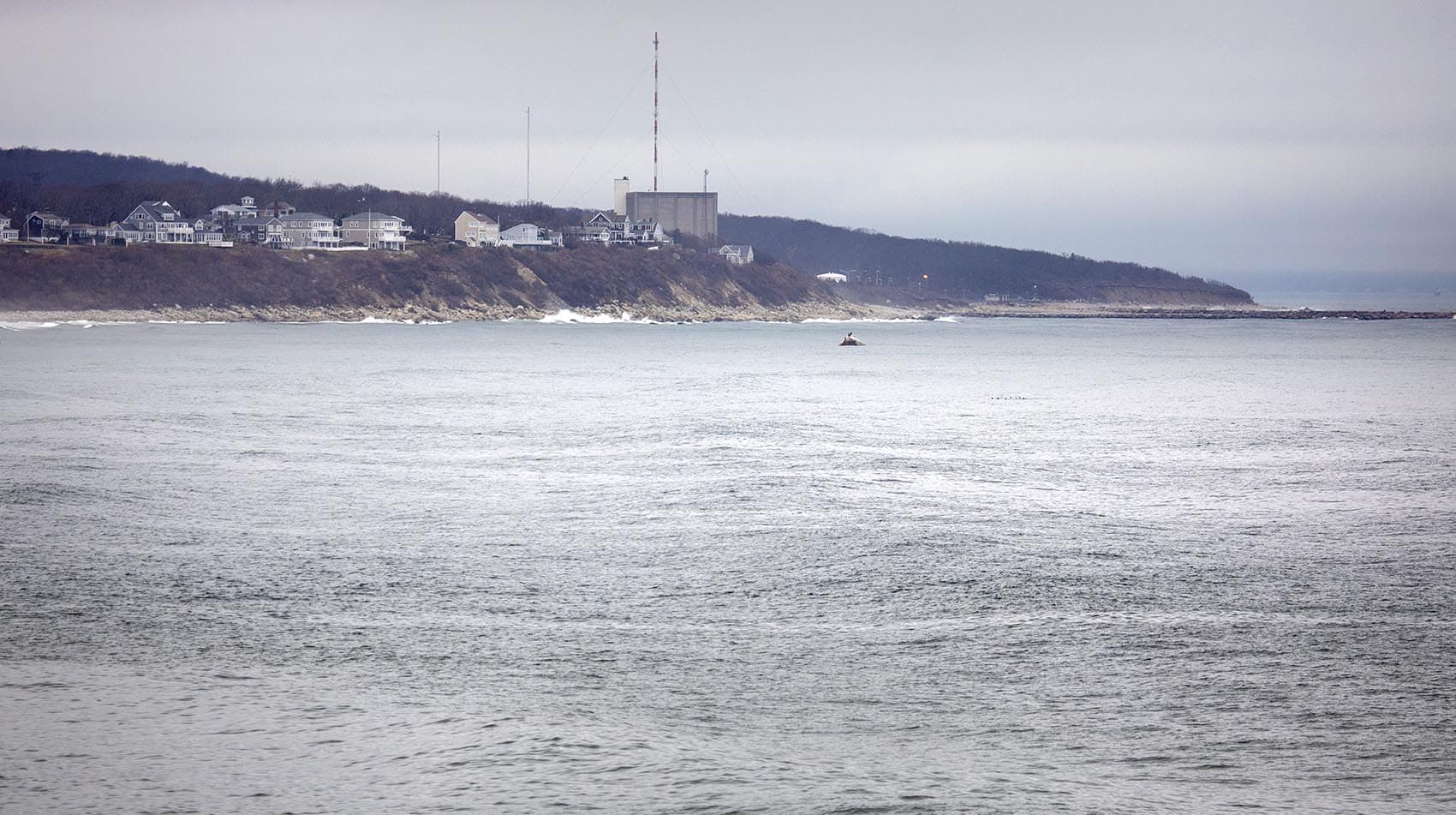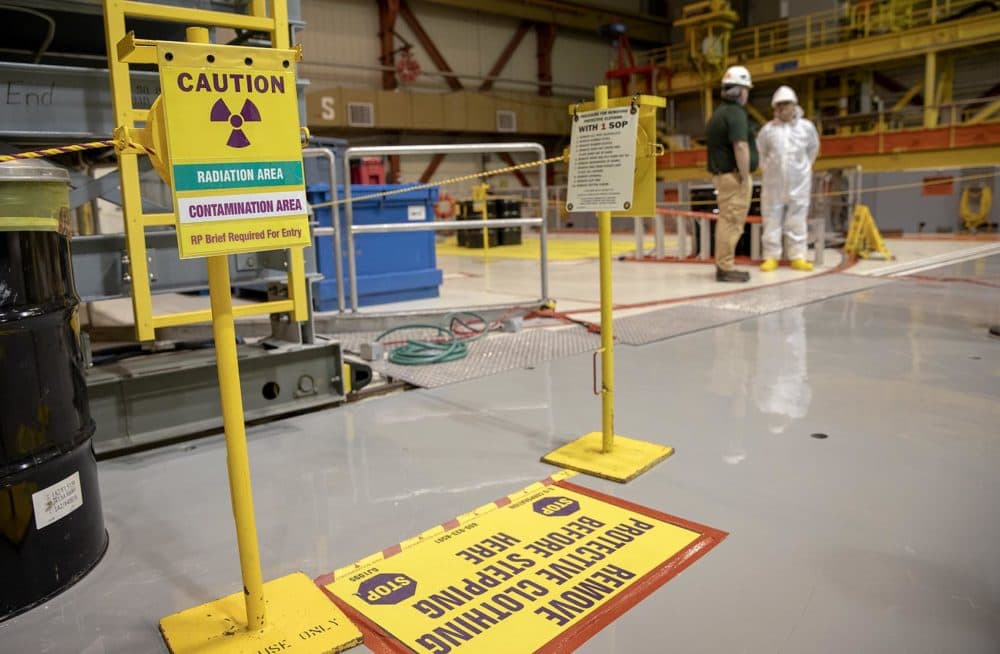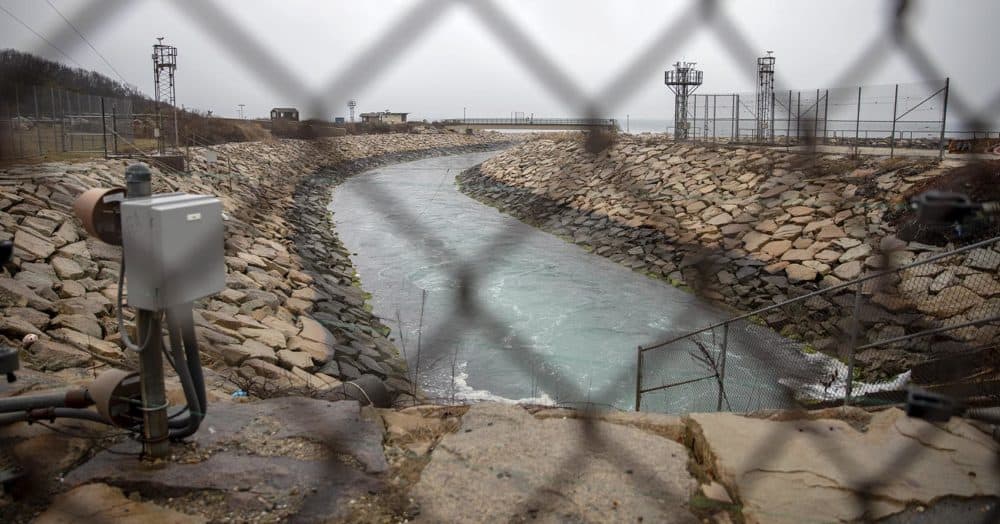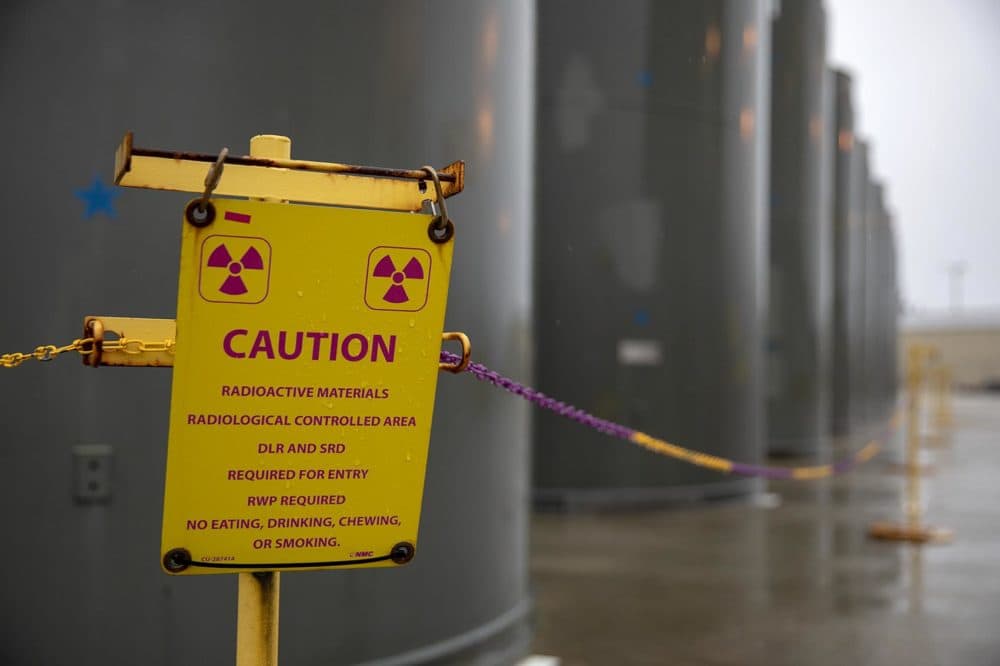Advertisement
Closing Pilgrim
You Asked, We Answered: Questions About The Pilgrim Shutdown

With the Pilgrim Nuclear Power Station closing for good, we thought WBUR readers and listeners might have a lot of questions. Turns out you do!
We asked you to tell us what you wanted to know, and many of you got back to us with smart questions. Here are our answers.
1. Nuclear power is one of our only zero-carbon energy sources, and blunting climate change will mean finding ways to keep existing plants operating. Why wasn't it possible to keep Pilgrim open longer? — Wade Roush
The short answer? Money.
Back in 2015, when Pilgrim’s owner, Entergy Corp., announced it would close the plant, it cited three factors: “poor market conditions, reduced revenues and increased operational costs.”
Let’s take these one-by-one. In the last decade or so, the cost of producing power has dropped because more cheap natural gas and renewables like solar and wind have come onto the market. Lower wholesale energy prices have made it harder for nuclear power plants, which have a lot of fixed costs, to compete. According to Entergy, keeping Pilgrim open meant losing $40 million in revenue every year — something the company decided was untenable.
That brings us to the next factor: Entergy didn’t think market conditions would improve in the near future. The company has argued that if the state is going to subsidize renewable energy sources, it should also help Pilgrim, which provides a lot of carbon-free electricity. But while some states have helped nuclear plants — in March, Connecticut provided a lifeline to the Millstone Station by promising to buy its power for the next 10 years — Massachusetts hasn’t done the same for Pilgrim.
And keeping the aging Pilgrim plant open would cost Entergy a lot of money.
“While we will always make needed investments at any plant, we also take into account the effect on our stakeholders of operating over the long-term if it is not economically viable to do so,” Entergy wrote in a statement.

2. Many of you asked about the proposed sale of Pilgrim to Holtec International. Who makes that decision, what does it mean for the decommissioning timeline, and is there any guarantee the public won't be left "holding the bag" if Pilgrim's owner goes bankrupt?
In August 2018, Entergy announced a plan to sell Pilgrim to Holtec International for decommissioning — a process that involves storing the spent fuel, tearing down the plant, and restoring the site. Massachusetts Attorney General Maura Healey and citizens' group Pilgrim Watch have expressed concerns about the proposed sale, and filed petitions to intervene with the federal Nuclear Regulatory Commission. Those petitions are still pending, and the NRC will ultimately decide whether to approve the sale and license transfer.
Holtec has proposed decommissioning the plant in about eight years, and removing the spent fuel by 2062. Critics like Healey and Pilgrim Watch worry that Holtec lacks the experience for such a rapid decommissioning, that Entergy's $1 billion decommissioning trust fund won't cover the costs, and that residents will be left to pay for the cleanup.
Joy Russell, senior vice president of communications for Holtec, calls their cost estimate "conservative" and says that the NRC puts the company "on the hook" for the decommissioning. "There's no way to pull up stakes and run away," she says.
NRC spokesman Neil Sheehan concurs. He says that the NRC will evaluate ongoing decommissioning costs and force the owner to make adjustments — through the Department of Justice, if necessary. "They need to complete the radiological cleanup of that site," says Sheehan. "They're going to live up to that obligation."
That being said, with no national repository in sight, there's a chance that waste could be stored at Pilgrim (or rather, the former Pilgrim) indefinitely. Sheehan said in an email that "The plant's owner is responsible for covering the costs of maintaining spent nuclear fuel at the facility." But critics want more assurance.
"I don't think people quite appreciate the seriousness of this problem," says Plymouth resident Sean Mullin, who chairs the Nuclear Decommissioning Citizens Advisory Panel. "Even in some of the greatest cultures the world has ever known, like Egypt, there was nobody around after about 700 years to maintain these beautiful pyramids and other things they built. To suggest that someone will be around in 200 years and will have the financial desire to continue to support these — this is a problem."

3. Is there a guarantee that at some point the area will be clean enough for attracting new revenue-creating enterprises? Will there be penalties if acceptable results are not achieved? — Betsy Smith
It sort of depends on what you mean by “guarantee."
At the end of the decommissioning process, NRC officials will inspect the site. They’ll measure radiation in soil, groundwater and on any residual plant infrastructure like underground pipes. If the site is in compliance with federal radiation standards, the NRC will terminate the plant’s operating license and “release” the land for unrestricted use.
Like many things nuclear, that’s a bit jargon-y — but basically what it means is that if the plant owner has done a good job, the NRC will sign off on the inspection and terminate oversight, allowing the owner to do whatever it wants with the land. “Unrestricted use” in this case means the area could be turned into “new revenue-creating enterprises” — beachfront condominiums, a shopping mall or even a school or playground. It could also be turned into a park or nature preserve for the public.
“Our regulations require that the site be cleaned up so that someone living there 365 days a year, 24 hours a day would receive no more than 25 millirems of radiation exposure (above background levels),” NRC spokesman Sheehan says. “Our regulations do not require the return of the site to greenfield condition, though some states may mandate that.”
It’s worth noting that this 25 millirem/year figure is at the center of hot debate. On one side, you have the federal government, which says the standard is sufficient — Sheehan points out that it’s a fraction of the total radiation the average American receives every year.
And on the other side, you have the state, which wants the land cleaned to a lower 10 millirem/year standard. The Massachusetts Department of Public Health requires a 10 millirem/year standard for all other cleanup projects in the state, but in the case of Pilgrim, which is licensed by the federal government, federal standards apply.
“We're very focused on ensuring that whoever does the cleanup, whether it's Entergy or Holtec, that they meet the Massachusetts standard,” Assistant Attorney General Seth Schofield said. A spokeswoman for the Executive Office of Energy and Environmental Affairs echoed the sentiment.
But how exactly the state will enforce this standard remains to be seen. One option is to do what Vermont did and negotiate a cleanup standard with Pilgrim’s current and prospective owners as part of a license transfer deal. (Massachusetts took a step in this direction when it filed for intervener status earlier this year.)
...but back to the specific question you asked. Will there be penalties for failing to properly clean the site?
The NRC's Sheehan says that if a plant owner doesn't meet federal cleanup standards during the inspection, what happens next depends on how egregious the issues are. If it's a problem of “low safety significance,” the NRC “would allow the owner to implement corrective actions” and then do another inspection. But for more serious issues, Sheehan says, “we could consider enforcement action, including the issuance of an order or orders.”
In the past, Sheehan has told WBUR that regardless of who owns the plant and what timeline is used for decommissioning, the NRC will make sure Pilgrim meets federal cleanup standards, even if it means involving the Department of Justice. That said, there’s no precedent for a plant failing the post-decommissioning inspection, so it’s a little tough to predict how events would play out.
4. If an accident takes place five, 10 or 20 years from now, who will compensate residents for loss of life, health and property, and who will make the land and surrounding waters safe? — Candace Perry
The NRC requires that the plant's owner maintain insurance for the plant following the permanent shutdown of Pilgrim.
But, says NRC spokesman Sheehan, "the amount of insurance coverage would be significantly reduced, commensurate with the reduced safety risk once the reactor is no longer operating." Sheehan notes that the NRC "will continue to inspect the plant throughout the decommissioning process."

5. A lot of you had questions about Pilgrim's spent fuel. You asked where the fuel rods are stored now, when and how they'll be moved to dry casks....
There are currently 580 fuel assemblies in the reactor and 2,378 in Pilgrim's spent fuel pool. There are 1,156 more in 17 huge steel-and-concrete drums called "dry casks," sitting on a concrete pad outside the reactor building.
After Pilgrim's reactor powers down, workers will move the assemblies from the reactor to the spent fuel pool, keeping them underwater the whole time. After the assemblies sit in the pool for a few years to cool off, workers will bring steel canisters into the spent fuel pool — one at a time — then load the fuel assemblies into the canisters underwater. Each canister holds 68 fuel assemblies.
After fuel is loaded, workers put a lid on the canister, weld it, drain it, vacuum dry it, and use a crane to lower it into an "overpack.” The overpack is another steel can, about 20 feet tall and 11 feet in diameter, with an inner doughnut of concrete and steel more than 2 feet thick. When the fuel its packed, it will be transported — verrryyy slowly — to a concrete pad that will be constructed at 75 feet above sea level, partly to account for sea level rise. In the end there will be 61 casks of spent fuel, and they'll sit there until there's somewhere else for them to go.
...and whether those casks will regularly inspected...?
At a March public meeting in Plymouth, NRC Reactor Decommissioning Branch Chief Bruce Watson said that the NRC is currently working with industry to develop surveillance and testing requirements, and that the storage facility would be inspected "at least annually."
NRC spokesman Sheehan confirmed that federal regulators will perform inspections when the concrete storage pad is being constructed, when dry casks are being loaded and when they are being moved. Once all of the dry casks have been loaded and moved to the storage pad, says Sheehan, the NRC "will periodically inspect the operations there, including its security."
He added: "The plant owner is responsible for monitoring the [casks] on an ongoing basis. This includes checking the air vents on a daily basis to ensure they are not clogged."
... and a couple more questions about those dry casks: How long does the manufacturer guarantee them for? What happens if a there's a leak or a crack?
Dry-cask manufacturer Holtec answered this one in an email:
The life expectancy of the stainless-steel canister, which is the primary containment of the spent nuclear fuel, varies based on the environment. Conservative estimates put the life expectancy of the canister at hundreds of years. As part of the aging management program, there are regular inspections of canisters that will check the entire surface of a single canister, or part of the surface of multiple canisters. If these inspections would ever indicate an imperfection or crack, canisters would be re-packaged before a crack could propagate and a leak occur. There is sufficient time to re-package the canister since it would take many years for an crack to develop into a leak.
Not everyone loves this Russian-nesting-doll solution. Mullin, the chair of the Nuclear Decommissioning Citizens Advisory Panel, says: "They should have something better in mind."

6. Where will the energy to make up for the plant closure come from? Renewable energy or fossil fuel burning? — Joshua Bowen
How is this going to affect the state/region's carbon reduction goals? — Jake Kailey
These are tough and very interesting questions, but the short answer is ... we’ll see.
According to ISO New England, which oversees the operation and wholesale electricity market in the region, there is more than enough generation capacity in New England to meet our needs when Pilgrim closes.
Pilgrim currently produces about 680 megawatts, or 5% of the region’s annual electricity, which is enough to power about 600,000 homes. The regional generating capacity is between 31,000 and 33,000 MW, depending on the season. That includes natural gas, the Seabrook and Millstone nuclear plants, hydro, solar, wind, wood, refuse and landfill gas.
The energy mix used to generate electricity changes every few minutes, depending on the market price. For example, if wind is cheaper than natural gas, it is put into the wholesale energy market first.
Pilgrim produced zero greenhouse gas emissions, so at least in the short term, closing the plant means regional emissions will go up.
However, under the Global Warming Solutions Act and the Regional Greenhouse Gas Initiative, utilities must acquire increasing amounts of energy from carbon-free sources. The current standard will reduce greenhouse gases distributed by electric utilities to 80% of the 1990 level by 2050. There are pending bills (H.832/S.524) that would make this net zero by mid-century.
The Baker administration says Massachusetts is on target to meet its 2020 goal of 25% reduction. As of 2016, it was at 21.4%.
The bigger challenge is reducing greenhouse gas emissions from vehicles and buildings. Currently, there are no mandates on the books to curb them.
Correction: An earlier version of this Q&A incorrectly stated that the decommissioning trust fund is the state's, not Entergy's. We regret the error.
This article was originally published on May 28, 2019.


